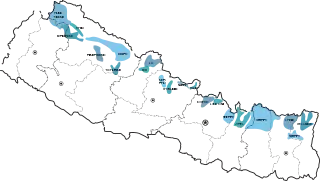Kyirong–Kagate languages
Kyirong–Kagate is a subgroup of Tibetic languages spoken primarily in Nepal, with a hundred or so speakers across the border in Tibet.
| Kyirong–Kagate | |
|---|---|
| Region | Nepal, China |
Native speakers | 16,000 (2000 – 2011 census)[1] |
| Language codes | |
| ISO 639-3 | Variously:kgy – Kyirongsyw – Kagatettz – Tsumscp – Hyolmogyo – Gyalsumdo |
| Glottolog | kyir1235 adds Nubri |
 | |
Varieties are:[2]
Although there is a varying degree of mutual intelligibility between these varieties,[3] they are considered separate languages by their respective speakers. There are also some major distinctions. For example, Kyirong has a three-tone system[4] whereas Yolmo and Kagate have a two-tone system.[5] The Gyalsumdo language variety spoken in the Manage district of Nepal shows strong similarities to Kyirong, as well as Nubri, and would therefore likely be classed in the "Kyirong–Kagate" group.[6]
Terminological limitation
The language family is best considered to really be Kyirong–Yolmo.[3] This is for a number of reasons; firstly, there are only around 1000 people who identify as Kagate, and many of these also consider themselves to be Yolmo. Secondly, Kagate is only regularly used to identify the community in Ramechhap, while Yolmo can be found in Melamchi, Helambu, Ilam, Lamjung and other places. Thirdly, the name Kagate is considered negative by many speakers, as it refers to the low-caste occupation of papermaking.
Variation between languages
These varieties are all clearly historically related,[2] but some are more similar than others. Kagate and Yolmo share many common features, and can be considered mutually intelligible dialects.[5][7] Nubri and Gyalsumdo also appear to be closely related, based on initial research.[6] Although Yolmo and Kyirong are more similar to each other than they are to Standard Tibetan, they are different enough to be considered different languages.[8]
References
- Kyirong at Ethnologue (18th ed., 2015) (subscription required)
Kagate at Ethnologue (18th ed., 2015) (subscription required)
Tsum at Ethnologue (18th ed., 2015) (subscription required)
Hyolmo at Ethnologue (18th ed., 2015) (subscription required)
Gyalsumdo at Ethnologue (18th ed., 2015) (subscription required) - N. Tournadre (2005) "L'aire linguistique tibétaine et ses divers dialectes." Lalies, 2005, n°25, p. 7–56
- Gawne, Lauren (2013). "Notes on the relationship between Yolmo and Kagate". Himalayan Linguistics. 12 (2): 1–27.
- Huber, Brigitte (2005). The Tibetan dialect of Lende (Kyirong). Bonn: VGH Wissenschaftsverlag.
- Hari, Anne Marie (2010). Yohlmo Sketch Grammar. Kathmandu: Ekta.
- Hildebrandt, Kristine Ann; Perry, J. Joseph (2011). "Preliminary notes on Gyalsumdo, an undocumented Tibetan variety in Manang District, Nepal". Himalayan Linguistics (10): 167–185.
- Gawne, Lauren (2010). "Lamjung Yolmo: a dialect of Yolmo, also known as Helambu Sherpa". Nepalese Linguistics (25): 34–41.
- Hedlin, Matthew (2011). An investigation of the relationship between the Kyirong, Yòlmo, and Standard Spoken Tibetan speech varieties (unpublished MA thesis). Payap University, Chiang Mai, Thailand.
